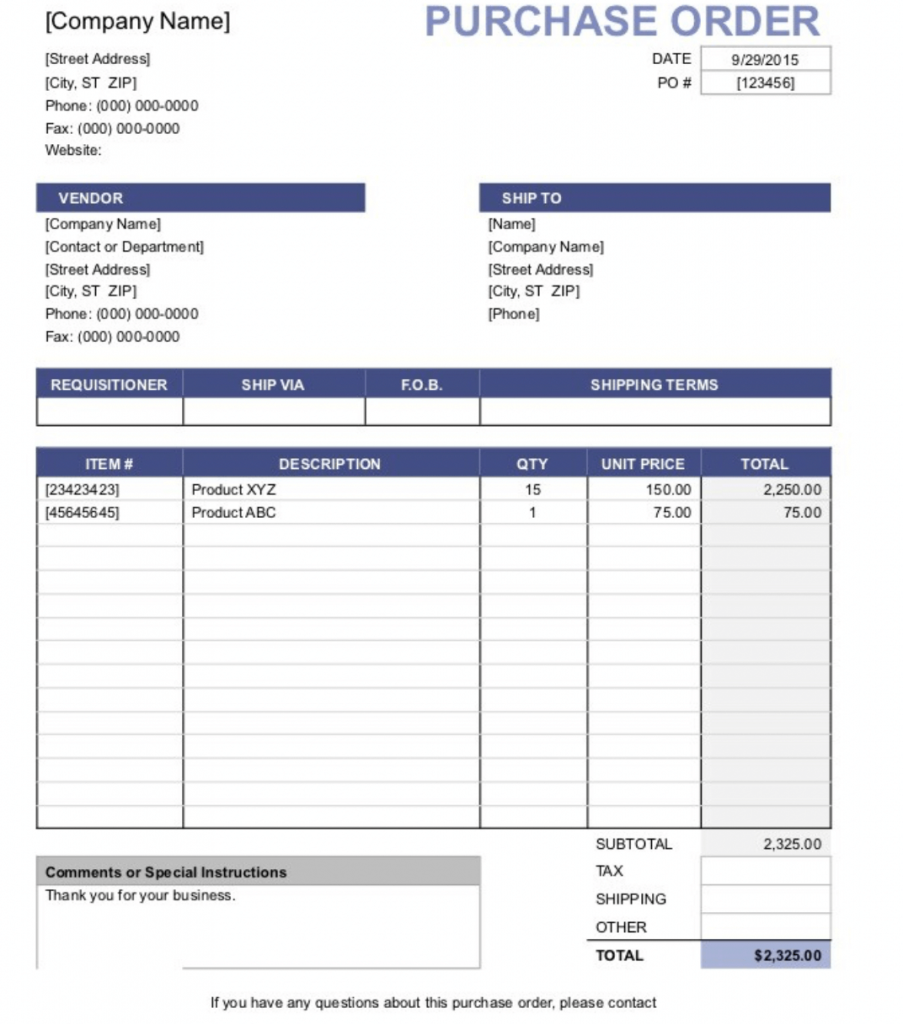The Purchase Order: A Guide to the basics
You may have found yourself pondering, “What exactly is a Purchase Order (PO)? How does it look, and what’s its function in the business world?” These are common questions for newcomers in procurement and business transactions. At Learn How to Source, we don’t just answer these questions – we dive deep into POs in one of our courses.
Table of Contents
Understanding the Purchase Order
A PO is much more than a mere document; it’s a contract created by the buyer and sent to the seller. It’s the cornerstone of many business dealings, framing the mutual rights and obligations (or conditions) between the parties involved. Think of it as a written authorization from a buyer, a formal request to acquire goods or services. But it’s not just a request – it’s a commitment, a promise of a transaction.
The Mutual Benefits of a Purchase order
Why are Purchase order beneficial, you ask? They provide clarity and security for both buyer and seller. The commitment described in a PO is two-fold: the seller commits to delivering, and the buyer usually commits to paying. This contractual agreement becomes legally binding once the supplier accepts the PO, ensuring that both parties are protected and aware of their obligations.
Specification and Clarity
By issuing a PO, businesses can articulate specifically what goods and services they require from their chosen suppliers, including the necessary timelines. This clarity is crucial in procurement – it’s like providing a map for the supplier to ensure they deliver exactly what is needed, when it’s needed. The PO holds the distinguished title of being the most important document in a procurement function.
Tactical vs. Operative Procurement
Understanding the distinction between tactical and operative procurement is essential. Tactical procurement involves negotiating the specific conditions under which the buying company will purchase. On the other hand, operative procurement is about placing the actual purchase order, executing the plan laid out by the planning team.
The Anatomy of a PO
What does a typical PO contain? It’s detailed and precise. A unique ID number to track and identify the order, the delivery date to ensure timely receipt, a list of requested products/services with their respective quantities, and, crucially, the price of each product. And let’s not forget about delivery terms, often outlined using Incoterms 2020, which provide an international standard for shipping and logistics. But there is more if you are interested, hence our course the Purchase order.
The Course: Crafting a Strong Purchase Order
At Learn How to Source, we offer an enlightening course on crafting a strong PO. This course is designed to guide you through the intricacies of creating a PO that leaves no room for misunderstandings. A well-structured PO minimizes the risk of incomplete or incorrect deliveries. It’s an opportunity for the buyer to communicate their needs explicitly and for the seller to understand exactly what is expected.
Enhance Your Buyer Skills
This course isn’t just about learning; it’s about enhancing your skills as a buyer. It’s concise, yet comprehensive, taking approximately 20 minutes to complete online. The best part? It’s available 24/7, allowing you to learn at your own pace, at a time that suits you. Enrollment is easy – just use your credit card, Apple Pay, Google Pay or PayPal for payment.
Course Highlights
- Interactive Learning: Engage with interactive content that makes learning about POs both fun and effective.
- Real-World Examples: Understand the application of POs in real business scenarios, enhancing your practical knowledge.
- Expert Tips: Gain insights from procurement experts on avoiding common pitfalls in PO creation.
- Instant Access: Start learning immediately after enrollment – no waiting, no hassle.
Join Us
So, if you’re eager to delve into the world of Purchase Orders, to understand their significance, and to master the skill of creating them effectively, this course is for you. It’s not just a learning experience; it’s a step towards becoming a more proficient, confident, and successful professional in the procurement field. To the course The Purchase Order.
Looking forward to guiding you on this journey!
Best Regards,
Fredrik
Note: The course, while brief, is packed with valuable insights and practical knowledge. It’s designed to fit into your busy schedule while providing all the information you need to become proficient in managing POs. Join us at Learn How to Source and transform your understanding of Purchase Orders. This course is your key to unlocking a world of efficient, effective procurement practices.
More about the course:
Basic course – part if the operative buyer role
If you work in procurement or supply chain management, you know that writing accurate POs are crucial for the success of your organization. Our online course about the importance of writing correct POs is designed to help you master this essential skill and improve your overall procurement processes.
A Purchase order is the foundation of any procurement operation, and a single mistake can have serious consequences, including delays, cost overruns, and even legal issues. Our course will teach you the best practices for writing accurate purchase orders, including how to clearly define specifications, identify terms and conditions, and ensure that all necessary information is included.
Through a series of engaging and interactive lessons, you’ll learn how to create error-free purchase orders that meet the needs of your organization and suppliers. You’ll also discover how to streamline your procurement processes, reduce the risk of errors, and improve your overall procurement performance.
Our online course is designed to be accessible and flexible, allowing you to learn at your own pace and on your own schedule.
Investing in your procurement skills and knowledge is essential for the success of your organization, and our online course is the perfect way to take your career to the next level. Enroll today and discover the power of accurate purchase orders!
Understanding the Purchase Order Process: A Step-by-Step Guide
The Purchase Order (PO) process is a critical component in the procurement and supply chain management of any organization. It is a systematic approach that ensures the smooth acquisition of goods or services, while maintaining strong internal controls and efficient vendor management. Here’s an informative breakdown of each step in the PO process:
1. Creating a Purchase Order
The process begins with the purchasing department selecting a vendor and agreeing on terms. A purchase order form is completed, often using an Enterprise Resource Planning (ERP) system with a procurement module. This electronic PO system ensures accuracy and efficiency in order creation.
2. PO Approval
Within the purchasing or procurement department, an authorized individual approves the purchase order. This step often involves confirming that an approved purchase requisition exists. For larger orders, a more detailed, formal legal contract may also be created and signed.
3. Sending the PO to the Vendor
The purchasing department then sends the PO to the selected vendor. This step is crucial as it officially communicates the buyer’s intent and order details to the supplier.
4. Vendor’s Confirmation of PO
Upon receipt, the vendor confirms acceptance of the PO, typically sending a purchase order confirmation back to the customer. This may involve the vendor ordering parts, manufacturing goods not in stock, and preparing for delivery. The PO becomes a legally binding agreement upon this confirmation.
5. Receipt of Goods or Services
The customer receives the goods or services as ordered. In cases where items are backlogged, partial shipments may be received.
6. Vendor Invoices the Customer
Post-delivery or shipment, the supplier invoices the customer. The invoice typically includes identifying details like the invoice number, customer account number, and PO number. The customer records these amounts as accounts payable.
7. Three-Way Matching of Documents
This step involves internal control measures where the customer matches the vendor invoice against the PO and receiving report or vendor packing slip. This matching process also includes verifying mathematical accuracy in invoices.
8. Invoice Approval
Authorized approvers in the customer’s organization review the matched documents and approve the invoices for payment.
9. Paying the Approved Invoice
Depending on the terms (e.g., early payment discounts), the customer pays the vendor invoice, adjusting accounts payable in the accounting software accordingly.
10. Closing the PO
Once all goods or services have been received, invoiced, and paid for, the purchasing department closes the PO.
Additional Considerations

- PO Flip: Some vendors may utilize a PO flip to automate invoice creation from digital PO information in the procurement system. This streamlines the invoicing process and reduces errors.
- ERP Systems: The use of ERP systems in PO processing enhances efficiency, accuracy, and traceability. It also facilitates better inventory management and financial planning.
- Legal and Contractual Aspects: The PO process also involves legal and contractual considerations, particularly for larger orders or more complex procurement needs.
- Internal Controls: Throughout the process, strong internal controls are essential. This includes the three-way matching of documents, which is a key component in preventing fraud and ensuring that only legitimate and accurate invoices are paid.
The PO process is a cornerstone of effective procurement and supply chain management. It not only ensures that goods and services are acquired efficiently and at the best value but also maintains compliance and control within the organization’s financial practices. Understanding and effectively managing this process is vital for any procurement professional or business manager.
Note: Illustration to the blogpost “The importance of a Purchase Order” was created by Chat-GPT on July 9, 2024.
Tips: Visit Utbildning inköp for information about LHTS in Swedish.
